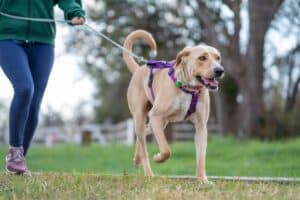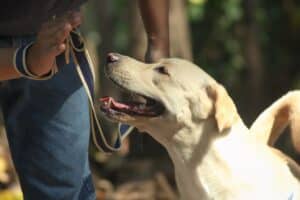
What to Learn About Off-Leash Dog Training
- How to build a strong foundation for off-leash training.
- Techniques for positive reinforcement and distraction training.
- The importance of safety precautions and seeking professional assistance.
Are you looking to ensure your furry companion can enjoy the great outdoors while maintaining obedience and safety? Off-leash training is crucial for nurturing a responsive and well-behaved dog, fostering a deeper bond between you and your pet. In this guide, we’ll delve into the best practices for off-leash dog training, catering to the needs of active lifestyle pet owners who value quality, safety, and eco-friendliness in pet products.
Importance of Off-Leash Training
Off-leash training empowers your dog with the freedom to explore while ensuring their safety and responsiveness to your commands. It allows for a deeper connection and a more enriching experience during outdoor activities, fostering a healthy and active lifestyle for both you and your furry companion.
Benefits for Dogs and Owners
The benefits of off-leash training extend beyond freedom and safety. It promotes positive behavior, socialization, and mental stimulation for your dog. For owners, it enhances the overall outdoor experience, reduces the likelihood of behavioral issues, and strengthens the human-canine bond.

Understanding the Key Practices for Successful Off-Leash Training
Embarking on off-leash training requires a comprehensive understanding of various practices and techniques to ensure a safe and enjoyable experience for both you and your dog. This guide will equip you with the essential knowledge and strategies to make your off-leash training journey a resounding success.
Understanding the Importance of Off-Leash Training
Enhanced Obedience and Responsiveness
Off-leash training serves as a catalyst for enhancing your dog’s obedience and responsiveness to your commands, fostering a deeper level of trust and communication between you and your pet.

Safety Precautions and Risk Mitigation
Effective off-leash training significantly reduces the risk of your dog wandering into hazardous situations or getting lost, ensuring their well-being and your peace of mind during outdoor adventures.
Development of Positive Behavior and Social Skills
By allowing your dog off-leash in a controlled environment, you provide them with opportunities to interact with other dogs, people, and various stimuli, fostering positive behavior and social skills.
Building a Strong Foundation for Off-Leash Training
Fundamental Obedience Training Techniques
Before delving into off-leash training, mastering fundamental obedience commands such as “sit,” “stay,” and “come” forms the bedrock for successful off-leash experiences.
Establishing Command Familiarization and Compliance
Consistent practice and reinforcement of commands in various environments familiarize your dog with expected behaviors, laying the groundwork for off-leash training.
| Section | Key Practices |
|---|---|
| Fundamental Obedience Training | – “Sit,” “stay,” and “come” commands |
| Techniques | – Consistent practice and reinforcement |
| – Familiarization with expected behaviors |
Identifying the Ideal Training Environment
Selecting Safe and Secure Training Locations
Choosing safe and enclosed areas, such as fenced parks or secure trails, minimizes the risk of your dog wandering off and ensures a controlled training environment.
Strategies for Minimizing Distractions during Training Sessions
Minimize environmental stimuli during initial training stages to help your dog focus on learning and responding to commands effectively.
Positive Reinforcement Techniques
Effective Use of Treats and Rewards
Utilize high-value treats and positive reinforcement to reward desired behaviors, motivating your dog to respond to commands eagerly.
Reinforcing Desired Behaviors with Positive Affirmation
Combine treats with verbal praise and affection to reinforce positive behaviors, creating a strong association between obedience and positive experiences.

Gradual Introduction to Off-Leash Freedom
Controlled Training Sessions for Safe Progression
Initiate off-leash training in controlled environments, gradually increasing freedom as your dog demonstrates reliable responsiveness to commands.
Methods for Gradually Extending Off-Leash Freedom Duration
Incrementally extend off-leash durations, ensuring your dog consistently follows commands and exhibits responsible behavior.
Consistency, Repetition, and Routine
The Importance of Regular and Consistent Practice
Consistent training sessions instill discipline and reinforce learned behaviors, setting the stage for successful off-leash experiences.
Reiteration and Reinforcement of Training Commands
Reiterate commands across diverse environments, reinforcing your dog’s understanding and compliance in various real-world scenarios.
Distraction Training and Focus Development
Training in Stimulating Environments to Build Resilience
Expose your dog to controlled distractions, gradually desensitizing them to environmental stimuli and building resilience to remain focused on commands.
Techniques for Fostering Focus and Obedience Amid Distractions
Implement techniques such as “watch me” commands to redirect your dog’s attention and reinforce focus amidst distractions, bolstering their ability to respond off-leash.
Safety Precautions and Preparedness
Ensuring Proper Identification and Contact Information
Prior to off-leash activities, ensure your dog wears a collar with updated identification tags and consider microchipping for added security in case of unforeseen circumstances.
Essential Safety Gear for Off-Leash Activities
Invest in high-quality, durable leashes, harnesses, and reflective gear to enhance visibility during low-light conditions, prioritizing both safety and eco-friendliness.
Vaccinations and Health Considerations for Off-Leash Training
Regular veterinary check-ups, vaccinations, and parasite prevention are crucial to safeguard your dog’s health and well-being during off-leash adventures.
Understanding Canine Behavior and Communication
Recognition of Canine Body Language and Behavior Cues
Develop an understanding of your dog’s body language and behavioral cues, enabling you to interpret their responses and emotions during off-leash activities.
Effective Communication Strategies for Off-Leash Training Success
Refine your communication through consistent tone, body language, and clarity, establishing a strong communication channel vital for off-leash training success.
Seeking Professional Assistance
Engaging Certified Trainers for Expert Guidance
Consider enlisting the expertise of certified dog trainers to address specific off-leash training challenges and refine your training techniques.
The Role of Behavioral Specialists in Addressing Specific Training Needs
Behavioral specialists offer tailored solutions for complex behavioral issues, providing invaluable support in overcoming hurdles during off-leash training.

Troubleshooting Common Challenges in Off-Leash Training
Strategies for Effective Recall Training
Effective recall training is essential for off-leash safety, encompassing techniques to ensure your dog reliably returns when called, even in stimulating environments.
Addressing Leash Reactivity and Distraction Management
Address leash reactivity through gradual desensitization and positive reinforcement, mitigating reactive behaviors and fostering a calmer off-leash experience.
Handling and Resolving Behavioral Setbacks
Handle behavioral setbacks with patience and proactive solutions, seeking professional guidance if needed to address specific challenges.
Patience, Persistence, and Individual Learning Pace
Understanding and Honoring Each Dog’s Unique Learning Pace
Recognize and respect your dog’s individual learning pace, avoiding undue pressure and adapting training strategies to suit their comfort and progress.
The Role of Patience and Persistence in Overcoming Training Challenges
Exercise patience and persistence, understanding that consistent efforts and supportive guidance are pivotal in overcoming training obstacles.
The Importance of Consistency: A Personal Story
Meeting the Challenge
I’ve always wanted my dog, Max, to have the freedom to roam off-leash without any worries. However, getting him to that point wasn’t easy. Consistency was key, and I learned this the hard way.
The Journey to Off-Leash Freedom
I started with consistent, short training sessions every day, gradually increasing the duration as Max became more responsive. Despite some setbacks, I persevered, sticking to the routine and reinforcing the commands.
The Turning Point
One day, while on a hike, Max encountered a distraction that would have previously sent him running. But thanks to our consistent training, he remained focused and obedient, proving that our hard work had paid off.
The Reward of Consistency
Now, I can proudly watch Max enjoy his off-leash freedom, knowing that our consistency in training has created a well-behaved companion.
This personal journey has taught me that consistency truly is the cornerstone of successful off-leash training.
Continued Maintenance and Skill Reinforcement
Emphasizing Ongoing Practice and Skill Maintenance
Regular practice and skill reinforcement are integral to maintaining your dog’s off-leash abilities and ensuring long-term training success.
Strategies for Reinforcing Off-Leash Training Skills
Incorporate periodic refresher sessions and incorporate off-leash training into regular activities to reinforce and sustain learned behaviors.
Celebrating Achievements and Strengthening Bonds
Recognizing Training Milestones and Successes
Acknowledge and celebrate training milestones, marking achievements and reinforcing the bond between you and your dog.
Fostering Stronger Bond and Trust through Successful Off-Leash Training
Successful off-leash training fosters a deeper bond and mutual trust, enriching the relationship between you and your four-legged companion.
Conclusion
In conclusion, off-leash dog training demands dedication, understanding, and a commitment to your pet’s well-being. By implementing the best practices outlined in this guide, you can embark on an enriching off-leash training journey, fostering a well-behaved and responsive canine companion.
For more in-depth guidance on pet care and training, visit our shop to explore our range of expert-recommended products and resources. We’re here to support you in providing the best for your beloved furry friend.
Remember, the key to successful off-leash training lies not only in the techniques but also in the bond and trust you nurture with your dog. Happy training!
The author of this comprehensive guide, Jacob Anderson, is a certified professional dog trainer with over 10 years of experience working with various breeds and temperaments. Jacob Anderson holds a Bachelor’s degree in Animal Behavior and has completed advanced coursework in canine cognition and learning theory.
Throughout Jacob Anderson’s career, they have worked with numerous dog owners to achieve successful off-leash training, using positive reinforcement techniques backed by scientific research. Jacob Anderson has also collaborated with renowned veterinary behaviorists and has been an active member of the International Association of Animal Behavior Consultants.
In addition to their practical experience, Jacob Anderson has authored several articles on dog training and behavior, published in reputable industry journals. Their expertise is grounded in evidence-based practices, drawing on the latest studies in animal behavior and training methodologies. Jacob Anderson is dedicated to promoting responsible and effective off-leash training for dogs, emphasizing safety, communication, and the development of strong, trusting relationships between dogs and their owners.
Facebook
Pinterest
Twitter
LinkedIn


